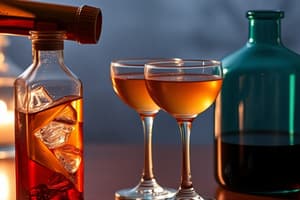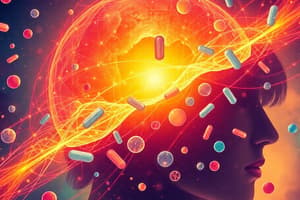Podcast
Questions and Answers
Lithium is considered the gold standard for treating which phase of bipolar disorder?
Lithium is considered the gold standard for treating which phase of bipolar disorder?
- Anxiety phase
- Psychotic phase
- Manic phase (correct)
- Depression phase
Which of the following instructions should be included in the teaching plan for a client prescribed lithium?
Which of the following instructions should be included in the teaching plan for a client prescribed lithium?
- Restrict sodium intake to prevent fluid retention.
- Discontinue medication if experiencing a metallic taste in the mouth.
- Maintain a consistent daily salt and fluid intake. (correct)
- Increase fluid intake only when feeling thirsty.
A client taking valproic acid reports a new hand tremor. Which action should the nurse take first?
A client taking valproic acid reports a new hand tremor. Which action should the nurse take first?
- Administer an anti-tremor medication as prescribed.
- Instruct the client to stop taking the medication immediately.
- Notify the healthcare provider to discuss potential dosage adjustment or alternative medications. (correct)
- Reassure the client that this is a common side effect and will subside.
Which mood-stabilizing medication is most closely associated with the risk of Steven-Johnson Syndrome?
Which mood-stabilizing medication is most closely associated with the risk of Steven-Johnson Syndrome?
A client taking carbamazepine reports symptoms of sore throat, fever and easy bruising. Which of the following is the priority nursing action?
A client taking carbamazepine reports symptoms of sore throat, fever and easy bruising. Which of the following is the priority nursing action?
Which of the following medication categories is NOT typically used to treat mental disorders?
Which of the following medication categories is NOT typically used to treat mental disorders?
What is indicated by a medication's 'half-life'?
What is indicated by a medication's 'half-life'?
Which of the following is the MOST serious warning that the Food and Drug Administration (FDA) can require for a medication?
Which of the following is the MOST serious warning that the Food and Drug Administration (FDA) can require for a medication?
A patient with schizophrenia is prescribed an antipsychotic medication. What is the primary mechanism of action expected from this medication?
A patient with schizophrenia is prescribed an antipsychotic medication. What is the primary mechanism of action expected from this medication?
A doctor is considering prescribing either haloperidol or risperidone to manage a patient’s psychotic symptoms. Which of the following considerations is MOST pertinent when choosing between these two medications, given they belong to different generations of antipsychotics?
A doctor is considering prescribing either haloperidol or risperidone to manage a patient’s psychotic symptoms. Which of the following considerations is MOST pertinent when choosing between these two medications, given they belong to different generations of antipsychotics?
A patient has been taking an antipsychotic medication for several months and suddenly stops taking it. What is the MOST likely recommendation a healthcare provider would give to avoid potential adverse effects?
A patient has been taking an antipsychotic medication for several months and suddenly stops taking it. What is the MOST likely recommendation a healthcare provider would give to avoid potential adverse effects?
A novel drug is discovered that stabilizes dopamine output. It increases dopamine activity when it's too low and decreases it when it's too high. Which of the following established medications has a SIMILAR mechanism of action?
A novel drug is discovered that stabilizes dopamine output. It increases dopamine activity when it's too low and decreases it when it's too high. Which of the following established medications has a SIMILAR mechanism of action?
Which of the following extrapyramidal symptoms (EPS) is typically treated with anticholinergic drugs or diphenhydramine?
Which of the following extrapyramidal symptoms (EPS) is typically treated with anticholinergic drugs or diphenhydramine?
A patient on a first-generation antipsychotic develops restlessness, anxiety, and agitation. Which EPS side effect is the MOST likely cause?
A patient on a first-generation antipsychotic develops restlessness, anxiety, and agitation. Which EPS side effect is the MOST likely cause?
Which of the following is the MOST appropriate action to take if a client misses a dose of their antipsychotic medication?
Which of the following is the MOST appropriate action to take if a client misses a dose of their antipsychotic medication?
What is the MOST critical intervention for a patient experiencing neuroleptic malignant syndrome (NMS)?
What is the MOST critical intervention for a patient experiencing neuroleptic malignant syndrome (NMS)?
Which of the following side effects of antipsychotic medications is considered irreversible?
Which of the following side effects of antipsychotic medications is considered irreversible?
Which of the following is NOT a common anticholinergic side effect associated with antipsychotic medications?
Which of the following is NOT a common anticholinergic side effect associated with antipsychotic medications?
Which second-generation antipsychotic is LEAST likely to cause weight gain?
Which second-generation antipsychotic is LEAST likely to cause weight gain?
A patient taking clozapine must have their white blood cell (WBC) count monitored weekly. What is the MINIMUM acceptable WBC count before the next week's supply can be dispensed?
A patient taking clozapine must have their white blood cell (WBC) count monitored weekly. What is the MINIMUM acceptable WBC count before the next week's supply can be dispensed?
Which of the following BEST describes the mechanism by which first-generation antipsychotics contribute to extrapyramidal symptoms (EPS)?
Which of the following BEST describes the mechanism by which first-generation antipsychotics contribute to extrapyramidal symptoms (EPS)?
Which neurotransmitter system is primarily affected by the major classes of antidepressant medications?
Which neurotransmitter system is primarily affected by the major classes of antidepressant medications?
A patient has been prescribed an MAOI. What dietary restriction is critical to teach this patient to prevent a hypertensive crisis?
A patient has been prescribed an MAOI. What dietary restriction is critical to teach this patient to prevent a hypertensive crisis?
Which class of antidepressants is often considered first-line due to its favorable side effect profile and safety in overdose?
Which class of antidepressants is often considered first-line due to its favorable side effect profile and safety in overdose?
A patient taking a TCA reports experiencing dry mouth, constipation, and blurred vision. These are most likely due to which type of side effect?
A patient taking a TCA reports experiencing dry mouth, constipation, and blurred vision. These are most likely due to which type of side effect?
Which of the following medications is classified as a conventional antipsychotic?
Which of the following medications is classified as a conventional antipsychotic?
Which of the following is NOT a typical use for antidepressants?
Which of the following is NOT a typical use for antidepressants?
Which of the following medications is administered via nasal spray and intended for use under the direct supervision of a healthcare provider?
Which of the following medications is administered via nasal spray and intended for use under the direct supervision of a healthcare provider?
What is the MOST likely rationale for administering cyclic antidepressants at night?
What is the MOST likely rationale for administering cyclic antidepressants at night?
Which antidepressant class is characterized by drugs that inhibit the breakdown of monoamines?
Which antidepressant class is characterized by drugs that inhibit the breakdown of monoamines?
Which medication is classified as a tricyclic antidepressant (TCA)?
Which medication is classified as a tricyclic antidepressant (TCA)?
A patient taking an SSRI consistently misses their morning dose. Up to how many hours after the scheduled time can they take the missed dose and still expect to maintain therapeutic efficacy?
A patient taking an SSRI consistently misses their morning dose. Up to how many hours after the scheduled time can they take the missed dose and still expect to maintain therapeutic efficacy?
A patient presents with agitation, diaphoresis, fever, tachycardia, and hyperreflexia after starting a new medication. Which of the following conditions is MOST likely?
A patient presents with agitation, diaphoresis, fever, tachycardia, and hyperreflexia after starting a new medication. Which of the following conditions is MOST likely?
A patient is prescribed an antidepressant that inhibits the reuptake of both serotonin and norepinephrine. Which class of antidepressants does this medication belong to?
A patient is prescribed an antidepressant that inhibits the reuptake of both serotonin and norepinephrine. Which class of antidepressants does this medication belong to?
Which of the following statements correctly differentiates SNRIs from SSRIs based on their mechanisms of action?
Which of the following statements correctly differentiates SNRIs from SSRIs based on their mechanisms of action?
Which of the following medications necessitates strict dietary restrictions due to the risk of hypertensive crisis when combined with tyramine-rich foods?
Which of the following medications necessitates strict dietary restrictions due to the risk of hypertensive crisis when combined with tyramine-rich foods?
Which of the following statements best reflects the current understanding of antidepressant mechanisms?
Which of the following statements best reflects the current understanding of antidepressant mechanisms?
A patient with treatment-resistant depression, failing two previous antidepressant trials, is being considered for esketamine treatment. Given the medication's unique administration requirements and mechanism of action, which of the following neurotransmitter systems is MOST directly targeted by esketamine?
A patient with treatment-resistant depression, failing two previous antidepressant trials, is being considered for esketamine treatment. Given the medication's unique administration requirements and mechanism of action, which of the following neurotransmitter systems is MOST directly targeted by esketamine?
A patient taking an antidepressant reports experiencing anticholinergic side effects. Which of the following antidepressants is most likely contributing to these effects?
A patient taking an antidepressant reports experiencing anticholinergic side effects. Which of the following antidepressants is most likely contributing to these effects?
A patient is being switched from an MAOI to an SSRI. What is the most critical consideration during this transition?
A patient is being switched from an MAOI to an SSRI. What is the most critical consideration during this transition?
A researcher discovers a novel compound that selectively enhances the degradation of a specific serotonin receptor subtype in the central nervous system. If this compound demonstrates antidepressant effects in preclinical trials, which existing class of antidepressants does its mechanism most closely resemble at a functional level, despite the difference in direct MOA?
A researcher discovers a novel compound that selectively enhances the degradation of a specific serotonin receptor subtype in the central nervous system. If this compound demonstrates antidepressant effects in preclinical trials, which existing class of antidepressants does its mechanism most closely resemble at a functional level, despite the difference in direct MOA?
Flashcards
Psychotropic drugs
Psychotropic drugs
Drugs used to treat mental disorders, including antipsychotics, antidepressants, mood stabilizers, anxiolytics, and stimulants.
Efficacy
Efficacy
The maximum therapeutic effect a drug can achieve.
Potency
Potency
The amount of drug needed to achieve maximum effect; high potency needs a lower dosage.
Half-life
Half-life
Signup and view all the flashcards
Off-label use
Off-label use
Signup and view all the flashcards
Black box warning
Black box warning
Signup and view all the flashcards
Antipsychotic drugs
Antipsychotic drugs
Signup and view all the flashcards
Acute dystonia
Acute dystonia
Signup and view all the flashcards
Pseudoparkinsonism
Pseudoparkinsonism
Signup and view all the flashcards
Akathisia
Akathisia
Signup and view all the flashcards
Neuroleptic Malignant Syndrome (NMS)
Neuroleptic Malignant Syndrome (NMS)
Signup and view all the flashcards
Tardive dyskinesia
Tardive dyskinesia
Signup and view all the flashcards
Anticholinergic drugs for EPS
Anticholinergic drugs for EPS
Signup and view all the flashcards
Anticholinergic side effects
Anticholinergic side effects
Signup and view all the flashcards
Metabolic syndrome
Metabolic syndrome
Signup and view all the flashcards
Agranulocytosis
Agranulocytosis
Signup and view all the flashcards
Fluphenazine
Fluphenazine
Signup and view all the flashcards
Risperidone and Clozapine
Risperidone and Clozapine
Signup and view all the flashcards
Aripiprazole
Aripiprazole
Signup and view all the flashcards
Antidepressants
Antidepressants
Signup and view all the flashcards
Four Groups of Antidepressants
Four Groups of Antidepressants
Signup and view all the flashcards
Examples of MAOIs
Examples of MAOIs
Signup and view all the flashcards
Examples of Tricyclic Antidepressants
Examples of Tricyclic Antidepressants
Signup and view all the flashcards
Examples of SNRIs
Examples of SNRIs
Signup and view all the flashcards
SSRIs Function
SSRIs Function
Signup and view all the flashcards
SNRIs Function
SNRIs Function
Signup and view all the flashcards
Antidepressant Interaction
Antidepressant Interaction
Signup and view all the flashcards
MAOI Action
MAOI Action
Signup and view all the flashcards
TCA Mechanism
TCA Mechanism
Signup and view all the flashcards
SNRI Action
SNRI Action
Signup and view all the flashcards
Common SSRI Side Effects
Common SSRI Side Effects
Signup and view all the flashcards
Cyclic Antidepressant Side Effects
Cyclic Antidepressant Side Effects
Signup and view all the flashcards
MAOI's Dangerous Interaction
MAOI's Dangerous Interaction
Signup and view all the flashcards
Serotonin Syndrome Symptoms
Serotonin Syndrome Symptoms
Signup and view all the flashcards
Brexanolone Use
Brexanolone Use
Signup and view all the flashcards
Mood-Stabilizing Drugs
Mood-Stabilizing Drugs
Signup and view all the flashcards
Lithium: Mechanism of Action
Lithium: Mechanism of Action
Signup and view all the flashcards
Common Lithium Side Effects
Common Lithium Side Effects
Signup and view all the flashcards
Side Effects of Carbamazepine & Valproic Acid
Side Effects of Carbamazepine & Valproic Acid
Signup and view all the flashcards
Mood-Stabilizing Drugs: Client Teaching
Mood-Stabilizing Drugs: Client Teaching
Signup and view all the flashcards
Study Notes
- Psychotropic drugs are used to treat mental disorders
- Categories of these drugs include antipsychotics, antidepressants, mood stabilizers, anxiolytics, and stimulants
Efficacy and Potency
- Efficacy refers to the maximal therapeutic effect a drug can achieve
- Potency is the amount of drug required to produce the maximum effect
- Low-potency drugs require a higher dosage
- High-potency drugs require a low dosage
Half-Life and FDA Role
- Half-life is the time it takes for half of the drug to be removed from the bloodstream
- The Food and Drug Administration (FDA) supervises the testing and marketing of medications to ensure public safety through clinical trials
Off-Label Use and Black Box Warning
- Off-label use refers to using a drug to treat a condition different from what it was originally tested for
- A black box warning indicates serious or life-threatening side effects, and is the most serious warning a medication can have
Principles
- Medication is selected based on its effect on target symptoms
- Effects may take about a month to be fully realized
- Use the lowest effective dose to stabilize target symptoms
- Lower doses are recommended for older adults
- Tapering medications is favored over abrupt cessation to avoid rebound, recurrence of symptoms, or withdrawal
- Follow-up care and a simple regimen increase compliance
Antipsychotic Uses and Mechanism
- Antipsychotics treat symptoms of psychosis, such as delusions and hallucinations
- They are used for schizophrenia, schizophrenia-like disorders, and the manic phase of bipolar disorder
- Off-label uses include treating anxiety, aggressive behavior and disruptive behaviors in Alzheimer's Disease (AD)
- Antipsychotics work by blocking dopamine receptors in the brain
Generations of Antipsychotics
- Conventional or first-generation antipsychotics include chlorpromazine, fluphenazine, thioridazine, haloperidol, and loxapine
- Atypical or second-generation antipsychotics include clozapine, risperidone, and olanzapine
- Third-generation antipsychotics, like aripiprazole, function as dopamine system stabilizers
Conventional vs Atypical vs Dopamine stabilizer
- Conventional antipsychotics are potent dopamine receptor blockers
- Atypical antipsychotics are weak dopamine receptor blockers and serotonin reuptake inhibitors
- Dopamine Stabilizers stabilize dopamine output, increasing it when it is too low and decreasing it when its too high
- Conventional antipsychotics treat positive symptoms with less effect on negative symptoms
- Atypical antipsychotics treat negative symptoms of schizophrenia
- Dopamine Stabilizers can treat both positive and negative symptoms
- Conventional antipsychotics have a high incidence of EPS, where as atypical have lower and stabilizers have less
Extrapyramidal Symptoms
- Extrapyramidal symptoms (EPS) result from dopamine blockage
- Acute dystonia involves muscle rigidity and can cause torticollis, opisthotonus, and oculogyric crisis
- Treatment includes anticholinergic drugs or diphenhydramine
- Pseudoparkinsonism presents with stooped posture, mask-like facies, shuffling gait, cogwheel rigidity, and coarse pill-rolling
- Treatment involves switching to a 2nd/3rd generation antipsychotic or using oral anticholinergics or amantadine
- Akathisia is characterized by restlessness, anxiety, and agitation
- Treatment includes anticholinergics, benzodiazepines, or beta-blockers
Anticholinergic Medications for EPS
- Benztropine is administered 1-3mg BID orally or 1-2mg IM/IV
- Biperiden is administered 2mg TID-QID orally or 2mg IM/IV
- Trihexyphenidyl is administered 2-5mg TID oral
Neuroleptic Malignant Syndrome and Tardive Dyskinesia
- Neuroleptic Malignant Syndrome (NMS) can be fatal and presents with muscle rigidity, high fever, and autonomic instability
- Management involves discontinuing the medication and providing supportive treatment for dehydration and hyperthermia
- Tardive dyskinesia involves permanent involuntary movements
- Symptoms includes tongue thrusting, lip smacking, and grimacing
- Also involves the neck and upper/lower extremities.
- Prevention with Abnormal Involuntary Mvt Scale
- Treatment: Valbenazine (Ingrezza)
Other Antipsychotic Side Effects
- Increased prolactin levels
- Weight gain; more likely with second-generation agents, except ziprasidone
- Metabolic syndrome: High blood pressure, sugar, cholesterol, obesity and greater abdominal girth
- Cardiovascular adverse effects: QT interval prolongation (thioridazine, droperidol, mesoridazine)
- Agranulocytosis (clozapine): Requires weekly WBC count monitoring; must have at least 3500 WBC count before obtaining the next week's supply
Antipsychotic Client Teaching
- Compliance with the medication regimen
- Management of side effects like dry mouth and Thirst(sugar-free candy, fluids), constipation (dietary fiber, exercise) and sleepiness/drowsiness(safety measures)
- If a dose is missed, it should be taken if it is within 4 hours of the usual time
Antidepressant Uses
- Used for major depressive illness, anxiety disorders, depressed phase of bipolar disorder and psychotic depression
Groups of Antidepressants
- Tricyclic and cyclic compounds (TCAs)
- Selective serotonin reuptake inhibitors (SSRIs)
- Monoamine oxidase inhibitors (MAOIs)
- Selective Norepinephrine Reuptake Inhibitor (SNRI)
- Miscellaneous Antidepressant
Mechanisms of Action
- The precise antidepressant mechanism remains not fully understood
- Antidepressants primarily interact with the monoamine neurotransmitter system
- The neurotransmitters affected are serotonin, norepinephrine, and dopamine
Key Points About Different Classes
- SSRIs are first-line drugs for depression due to their rapid effect (2-3 weeks), fewer side effects, and high safety
- SNRIs are newer antidepressants also considered first-line for depression and take effect in 2-4 weeks
- TCAs are used less frequently due to higher frequency of side effects and potentially lethal risk with overdose and take 4-6 weeks to be effective
- MAOIs may cause hypertensive crisis when taking tyramine-rich foods and take 2-4 weeks to be effective
Side Effects
- SSRIs: Anxiety, agitation, akathisia, nausea, insomnia & sexual dysfunction , and weight gain
- Cyclic antidepressants: Anticholinergic effects, orthostatic hypotension, sedation, weight gain, tachycardia and sexual dysfunction
- MAOIs: Daytime sedation, insomnia, weight gain, dry mouth, sexual dysfunction & orthostatic hypotension and hypertensive crisis with foods containing tyramine
Specific Foods to avoid
- Aged cheeses, aged meats, tap beers, sauerkraut, soy sauce, brewer's yeast, yogurt, sour cream
Antidepressant Interactions
- Serotonin Syndrome can occur with MAOI + SSRI
- Symptoms includes Agitation, sweating, fever, tachycardia, hypotension, rigidity, hyperreflexia, Coma and death
Antidepressant Drug Interactions: Treatment
- Muscle relaxants like benzodiazepines
- O2
- IV fluids
- Breathing tube and mech vent
- Beta blocker
Antidepressent - Client Teaching
- Dosing Time: SSRIs should be taken in the morning, cyclic at night
- Missed Doses: Take SSRI up to 8 hours after, cyclic within 3 hours or omit
- Safety measures: Avoid driving
Miscellaneous Antidepressants: Brexanolone and Esketamine
- Brexanolone stands as the first FDA-approved medication for postpartum depression, administered via a 60-minute infusion
- Esketamine effects glutamate by blocking NMDA, is approved for treatment-resistant depression, and defined as two failed antidepressant trials; can only be administered under direct supervision of healthcare provider for nasal spray and is not intended for home use
Mood-Stabilizing Drugs
- Used to treat the highs (manic phase) and lows (depression phase) of bipolar disorder
- mood-stabilizing medications: lithium (Eskalith, Lithobid) and anticonvulsants (carbamazepine, valproic acid, gabapentin, topiramate, oxcarbazepine, and lamotrigine)
Mechanisms of Action
- Lithium normalizes the reuptake of certain neurotransmitters
- Valproic acid and topiramate increase the levels of GABA
- Anticonvulsants stabilize neuron membranes
Lithium Side Effects
- Nausea, diarrhea, anorexia, fine hand tremor, polydipsia, polyuria, metallic taste, fatigue, lethargy, weight gain, acne
- Toxicity includes severe diarrhea, vomiting, drowsiness, muscle weakness, lack of coordination
- Maintain normal salt and fluid intake
- Therapeutic serum lithium level: 1.0mEq/L
- Carbamazepine and valproic acid can cause drowsiness, sedation, dry mouth, and blurred vision
Side Effects of Mood Stabilizers
- Carbamazepine: rash and orthostatic hypotension
- Valproic acid: edema, weight gain, alopecia, and hand tremor
- Topiramate: dizziness, sedation, and weight loss
Adverse Effects of Mood Stabilizers
- Lamotrigine can cause Steven-Johnson Syndrome
- Carbamazepine can cause aplastic anemia and agranulocytosis
Mood-Stabilizing Drugs: Client Teaching
- Periodic monitoring of blood levels, 12 hours after last dose
- Take medication with meals to minimize nausea
- Safety measures if with sedation or dizziness
Antianxiety Drug Uses
- Treatment of anxiety and anxiety disorders, insomnia, obsessive-compulsive disorder (OCD), depression, PTSD, and alcohol withdrawal
- Benzodiazepines and buspirone
Mechanisms of Action
- Benzodiazepines Binds to GABA receptor which reduces cellular excitation leading to a calming effect
- Buspirone acts as a partial agonist at serotonin receptors
Antianxiety Side Effects
- Benzodiazepines: Physical and psychological dependence & Central nervous system (CNS) depression
- Must be avoided with CNS depressants Alcohol, and tolerance of sedation
- Buspirone: Dizziness, sedation, nausea, and headache, and does not cause physical dependence
Other Drugs Used for Anxiety
- Symptoms, neurotransmitters, and circuits associated with anxiety/depressive disorders overlap extensively
- First-line treatment options include
- Benzodiazepine – fast onset; misuse potential
- Antidepressant – slow onset; but long term effect; the preferred choice for long-term treatment
Client Teaching for Anti-Anxiety
- Safety measures if there is sedation and avoidance of alcohol
- One drink while on a benzodiazepine may have the effect of three drinks
- Avoid abrupt discontinuation
- Benzodiazepine withdrawal can be fatal
Stimulant Uses and Medications
- Used for ADHD in children and adolescents, residual attention-deficit disorder in adults and narcolepsy.
- Medication includes Amphetamines; methylphenidate, amphetamine, and dextroamphetamine
- Non-stimulant medication: Atomoxetine (Strattera) – SNRI -Pemoline (Cylert) – infrequently used d/t liver failure
Mechanism and Dosage
- Causes a release of norepinephrine, dopamine, and serotonin presynaptically
- Dosage divided; higher doses for narcolepsy in adults
- Doses for treating ADHD vary widely (based on age, weight, and behavior of children)
Side Effects and Client Teaching for Stimulents
- Anorexia, weight loss, nausea and irritability
- Growth and weight suppression (long term effect)
- Can be prevented by taking drug holidays during weekends and holidays
- Dose after meals to minimize nausea and anorexia
- Avoidance of caffeine, sugar and chocolate
- Proper storage out of reach of children
Disulfiram
- Used as Aversion therapy for alcoholism
- Works by inhibiting the enzyme involved with alcohol metabolism
- Adverse reaction with alcohol ingestion; Facial and body flushing, throbbing headache, vomiting, dizziness Severe Symptoms: chest pain, severe hypotension, dyspnea, death
- Side effects: fatigue, drowsiness, halitosis, tremor, impotence
- Interacts with phenytoin, barbiturates, long-acting benzodiazepines
- Teach Patient avoidance of alcohol found in common products (e.g., shaving cream, deodorant, and over-the-counter cough preparations) with a alcohol free label
Acamprosate
- Prescribed for persons in recovery from alcohol abuse or dependence
- Works by reducing the physical and emotional discomfort during the first weeks/months of sobriety
- Persons with renal impairment cannot take these medications
Studying That Suits You
Use AI to generate personalized quizzes and flashcards to suit your learning preferences.




